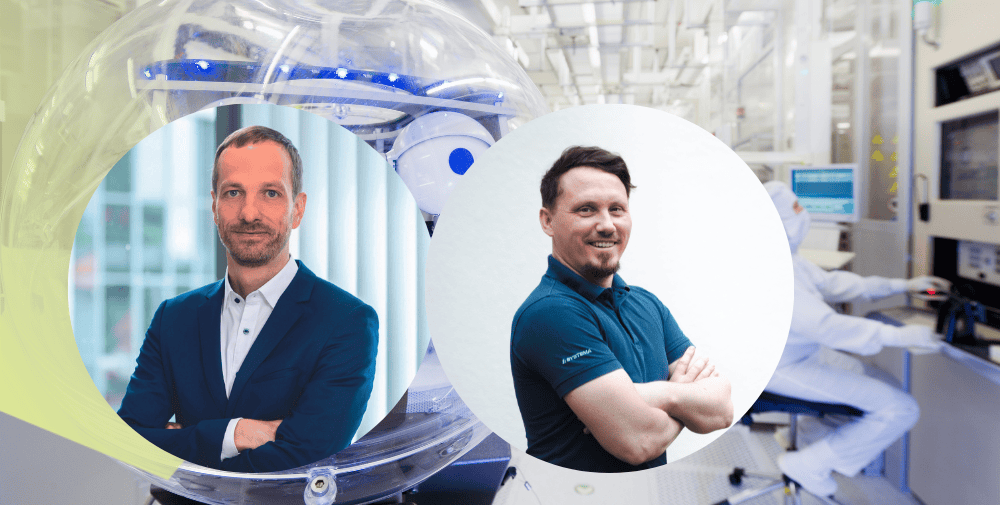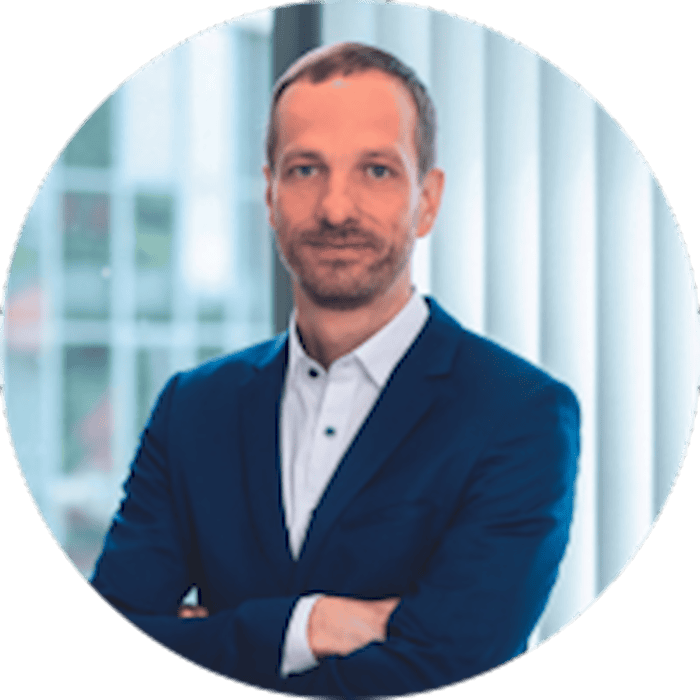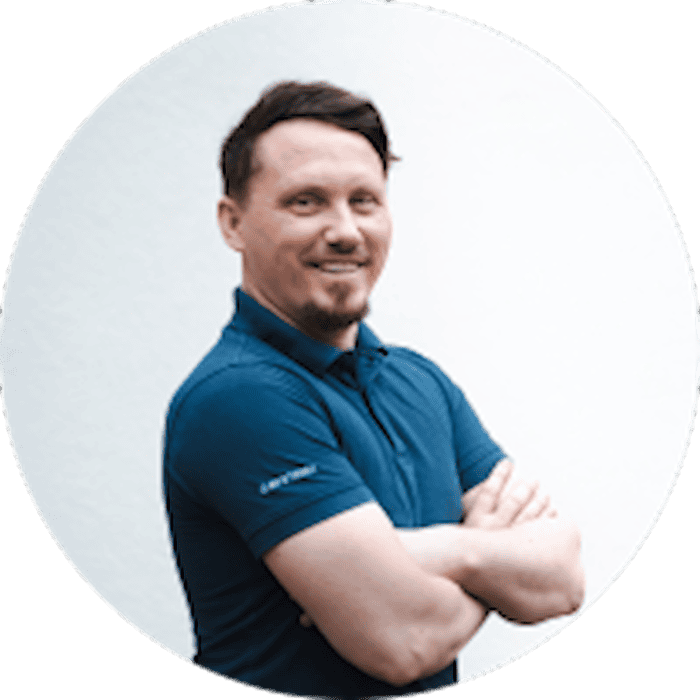How can software support the sustainability efforts of fabs? Which technology trends will shape the coming years and why are software service providers focusing on cooperation despite all the competition?
Categories
How can software support the sustainability efforts of fabs? Which technology trends will shape the coming years and why are software service providers focusing on cooperation despite all the competition?

Categories
Tags
Contact info
Silicon Saxony
Marketing, Kommunikation und Öffentlichkeitsarbeit
Manfred-von-Ardenne-Ring 20 F
Fax: +49 351 8925 889
Contact person:
For our NEXT magazine focusing on software, we discussed these and other questions with Frank Geißler (Director Sales, Kontron AIS) and Thomas Leps (Director High-tech Verticals, SYSTEMA). Both companies develop customized software solutions for the semiconductor industry and for the fabs located in the north of Dresden. While Kontron AIS focuses on equipment control, equipment interfaces and line control in the backend, SYSTEMA deals with MES and host systems or high automation in the frontend and backend. Their specific domain expertise and the often bespoke software solutions are typical of what many Saxon software companies have to offer.
Frank Geißler: Unlike other industries, the semiconductor industry is strongly defined by the standards developed by the SEMI organization. Various standards must be observed, particularly with regard to machine integration using SECS/GEM, GEM300 and EDA, which is common in the semiconductor industry. These also have a direct impact on machine control with regard to order management and automated loading using OHT (Overhead Transport) and AGV (Automated Guided Vehicle). Software development in the semiconductor industry therefore requires not only technical expertise, but also a deep understanding of the unique requirements of this highly specialized industry.
Thomas Leps: We see semiconductor pioneering in automation and production software: the standards Frank Geissler mentioned were established long before Industry 4.0. In our view, two key issues are the complexity of the processes and systems on the one hand and the quality requirements on the other. In semiconductor front-end production with 1,000 or more process steps means that everything has to work together like clockwork in a highly automated process with countless systems. Software adjustments and rollouts are usually done remotely and must not disrupt the fab’s ongoing operation, or as a colleague puts it, “it’s like heart surgery during a marathon” or the famous “changing tires on a rolling bus”. But software doesn’t change that often (yet): applications often run for decades. This “legacy software” still needs to be maintained and kept functional.
Frank Geißler: There has been a high level of integration in the semiconductor industry for decades. Connectivity as defined by Industry 4.0 was and is therefore already common practice, as is well as the use of data for process optimization. In recent years, the depthlevel of integration has even increased once again and smaller fabactories and backend locations are also using the more comprehensive GEM300 standard for plant integration. In this sense, the EDA standard is also being used to a greater extent to provide more comprehensive data for production by machines. In addition, the amount of software that semiconductor suppliers are providing to and on their products is increasing rapidly, making products more and more complex.
Thomas Leps: Many fab owners are pursuing the vision of the “lights-out fab”, i.e. they are constantly increasing the level of automation to remain competitive. In the past, the focus has been on supporting assisting and freeing up the operator, e.g. by making it easier to identify and start material; automated systems have been established to support the “happy path” where a sequence or process is completely mapped in software, with operators and engineers only intervening in the event of an error. The question now is, what else is possible without software? A good friend of mine recently put it boldly: “Every company has to become a software company; some just haven’t understood it yet”.
Frank Geißler: One challenge certainly lies in the targeted use of AI. The possibilities for process optimization and analysis are particularly extensive in semiconductor factoriesfabs with their very long lead timesproduction cycles (approx. 12 weeks and more) and highly integrated production landscape. The targeted and meaningful analysis of data representsis a major challenge. Software solutions provide support, e.g. through simulations, and thus enable the gradual validation and introduction of AI-based enhancements.
In smaller semiconductor factoriefabs, the degree of automation with regard to material handling is also being steadily increased using robot cells or AGVs. This poses challenges for the existing machines, which need to be enabled for automated loading, e.g. using E84. The necessary increase in integration depth and extended data exchange also pose challenges for existing fabs in particular. Software upgrades or targeted software enhancements are increasingly forming an important basis here.
Thomas Leps: That’s true, even more so with mass customization or mass personalization, which involves small batch sizes and a wide variety of products. And, we see another challenge that is common to all fabs: the shortage of skilled workers, be it in engineering, IT or operations and maintenance. While the focus used to be on freeing operators from simple, non-value-adding tasks, the focus is now on digitalization and the continuity of all processes in engineering and fab operations. However, a distinction must be made: Typically, the level of automation goes hand in hand with the wafer size, i.e. most 300mm front ends use automated transport and are highly automated. For smaller wafers (200mm), Infineon in Dresden and Bosch in Reutlingen stand out for their level of automation. Others still need to catch up.
Frank Geißler: There is great potential in the extensive possibilities of data generation in conjunction with AI. Semiconductor factoriefabs are accordingly interested in exploiting this and are therefore expanding their software teams around the topic of data management. The advantage of these departments certainly lies in the domain knowledge that can be built up and used without restrictions in terms of confidentiality.
External partners will continue to play an important role, however, as they also have extensive domain knowledge that could only be built up with disproportionate effort. The semiconductor industry is also subject to fluctuations and cycles that external partners can compensate for well, or at least better.
Thomas Leps: Absolutely right. At Infineon and other manufacturers, we see them deploying their own solutions where their own IP is a critical competitive advantage, often in defect detection or APC, for example. They work with external partners and specialists in production control and optimization when they can benefit from the experience of these software partners across the semiconductor supply chain.
Frank Geißler: Software solutions are already helping to improve sustainability in semiconductor factoriebs, for example by continuously optimizing yield and thus conserving resources. In addition, chip design tools are constantly evolving and enable the design of more efficient chips.
Thomas Leps: There is great potential in integrating and linking existing data. Simpler and more established examples include, in addition to increasing yields and avoiding scrap, as the startup of equipment that can be desynchronized by software to avoid peak loads, which supports the management of power grids, for example. Scheduling, for example, optimizes batch equipment that process multiple lots simultaneously, making more efficient use of resources. . In another example, clever product mix and sequence mean that chambers of complex cluster systems “clean” themselves and require no additional maintenance.
Frank Geißler: Generative AI is used to recognize patterns in data and independently derive and generate content. AI is already being used in semiconductor fabs to recognize patterns and carry out optimizations. In our view, generative AI does not yet play a major role here, as the necessary checks and monitoring in the multilayered production steps are very complex. In addition to production-related processes, however,, the usage of generative AI in general processes, e.g. in administration will increase and will result in efficiency gains.
All in all, the potential is huge and generative AI will certainly find even more applications in the semiconductor industry and thus also partially counteract the shortage of skilled workers.
Thomas Leps: There are amazing publications/papers in the field of chip design and anomaly detection, leading to faster detection and elimination of error sources. If you follow some editors, the pure developer without any consulting tasks seems to become replaceable or more productive, but the generated code is neither lean nor innovative, at least today. In practice, however, we often find that despite powerful solvers for material flow optimization, for example, there are still reservations about using these technologies: very few customers accept a black box in which decisions are not transparent. This is where we are gradually introducing users to ML/AI-based solutions. When it comes to solutions for the semiconductor industry, security and the protection of the customer’s IP play a very important role and can therefore slow down cloud helpers such as Copilot or tools for further test automation. Again, it is important to guide the users, communicate benefits, and limit risks. This is an ongoing change process that we actively support.
Frank Geißler: Thomas Leps has just mentioned it: The use of generative AI will also bring about a profound change in the field of software development. Developers with an AI co-pilot are already up to 50 percent more efficient than before.This also supports other activities such as documenting and commenting on software, as well as faster familiarization with third-party software, as the AI co-pilot explains the existing code and suggests improvements.
Software development will also be increasingly characterized by security issues. Even today, it is almost impossible to create systems that are not connected. This increases the risk of misuse, which requires higher security standards. Developers must take care of the software supply chain and quickly identify and rectify vulnerabilities. This means that in future there will no longer be any systems that are not subject to constant maintenance. Security updates and patches will be just as normal in machines as they are today in our smartphones or PCs. New business models will also be needed to make this economically viable. Delivery without maintenance and service concepts will no longer be possible.
Thomas Leps: We are also seeing new substrates such as SiC, GaN and GaAs triggering automation activities even in older fabs processing 150mm or 200mm wafers. In addition, approaches that are common in the Frontend are increasingly being used on the Backend. These include standardized equipment integration and, building on that, APC or single device traceability.
But compared to the increased use of AI, other issues are receding. Especially when it comes to the shortage of skilled workers. It’s not just a funny picture of the Pope in a winter coat that shows us how difficult it will be in the future to distinguish between human-made and AI-generated content. How do we ensure technical competence and provide access to software in the most playful way possible? We particularly appreciate the work of SiSax and its members on Calliope mini and in the European Chips Skills Academy (ECSA), the successor to METIS.
Frank Geißler: The innovative Dresden companies FabMatics, Xenon, SYSTEMA and Kontron AIS have joined forces in the Automation Network Dresden (AND). The cooperation takes place in various ways. For example, solutions and competencies of the partners are used in individual projects to expand the range of products and services or to support joint customers more comprehensively. There is also an exchange of experience between the companies. With the Innovation Forum in January, AND organized a two-day conference with almost 300 participants.
Thomas Leps: And not just this year. The Innovation Forum has been running for more than 20 years, attracting participants from all over the world. They recognize the efficiency and value of our network, especially because specialists like us work closely together not only on software, but also with the two equipment partners. The semiconductor industry will remain complex in the future and will only be successful with a well-functioning global value chain. SYSTEMA contributes with employees from 26 nations in 8 international sites.
Frank Geißler: The shortage of skilled workers is also omnipresent in the automation industry and represents a fundamental challenge. Kontron AIS has grown by 50 employees in the last two years and we are aiming for further growth in the future. In order to To counteract the shortage of skilled workers, foreign specialists have been and will continue to be necessary in the future. We are relyingbuild here also on the nearshoring capacities within the Kontron Group, among other things, which provide very goodexcellent access to highly qualified and motivated specialists.
Thomas Leps: We will only be able to successfully counter the shortage of skilled workers, even with or despite all the technical innovations, if we open up internationally, i.e. both by attracting skilled workers to Dresden/Saxony/Germany and establish by setting up offices where customers produce their chips and cooperate globally. For a high-tech location like Germany, it is particularly important to promote an affinity for technology and an interest in careers in the STEM fieldsnatural sciences and engineering.
Frank Geißler: I can only support what Thomas Leps has just said: The most important pillar is probablycertainly the trainingeducation of young people. This starts at school, where the technical aspects need to be developed, and ends with vocational training or university studies. We must also clearly position ourselves as a cosmopolitan Saxony and Dresden in order to attract national and international skilled workers.
Thomas Leps: And we need to cooperate -– like as in AND and Silicon Saxony. The upcoming and very compact ramp-ups of the frontend fabs will involve local players if we can join forces and also make offer a flexible and , responsive offer service to the industry giantsbig player. Surprisingly for us: you won’t find a strong supplier network like SiSax in Taiwan.
_ _ _ _ _ _
👉 The transformative power of generative AI
👉 Saxony’s software landscape: from highly specialized to globally important
👉 The five steps on the way to a digital business model
_ _ _ _ _ _ _

Frank Geißler
Director Sales
frank.geissler@kontron-ais.com | +49 351 21 66 0

Thomas Leps
Director Hightech Verticals
Thomas.Leps@systema.com | +49 351 882460
_ _ _ _ _ _
Kontron AIS GmbH has been setting the benchmark in industrial software for over 30 years with an experienced team of more than 250 employees. The proven software products and individual digitization solutions enable machine and plant manufacturers as well as factory operators to break new ground in automation in order to secure long-term competitive advantages. Together with its customers, Kontron AIS implements intelligent digitalization strategies and solutions for tomorrow’s smart manufacturing worldwide and across all industries.
As a subsidiary of Kontron AG, Kontron AIS GmbH offers integrated, holistic IoT concepts consisting of hardware and software as well as worldwide project management, service and support thanks to a global network.
👉 To the member profile incl. contact
_ _ _ _ _ _
SYSTEMA is a medium-sized company and was founded in 1993 by Dipl. Inf. Manfred Austen. In addition to its headquarters in Dresden, the company has locations in Regensburg and Bend, USA. SYSTEMA offers companies in the manufacturing industry comprehensive expertise in the selection and implementation of automation software as well as plant and system integration – from individual machines to highly automated production scenarios at global locations.
👉 To the company profile incl. contact
_ _ _ _ _ _
This interview was conducted exclusively for NEXT “In the spotlight: Software”.